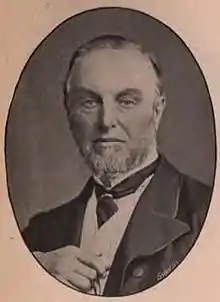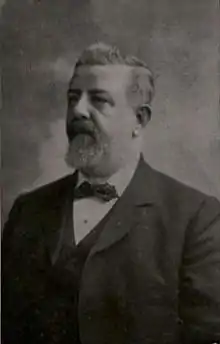Hallamshire (UK Parliament constituency)
Hallamshire was a Parliamentary constituency covering the Hallamshire district of England. The constituency was created in 1885 and abolished in 1918. The seat was a large geographical area which in the west included the moors of the Pennines (Howden Moors, Midhope Moors, Broom Read Moor, Bradfield Moor and Hallam Moor), but came down from the hills in the centre to include better farmland north of Sheffield around Ecclesfield. In the north-east it included part of the South Yorkshire coalfield and some mining villages. In the south, the residents of Sheffield who owned their freeholds could vote in this division.
| Hallamshire | |
|---|---|
| Former County constituency for the House of Commons | |
| County | West Riding of Yorkshire |
| 1885–1918 | |
| Seats | One |
| Created from | Southern West Riding of Yorkshire |
| Replaced by | Penistone, Rotherham and Wentworth |
For twenty years the Member of Parliament was the Sheffield cutler and steel manufacturer, Sir Frederick Mappin, who was able to unite the middle-class voters from Sheffield with the hill-farmers and the miners to vote for him as a Liberal. When he retired the local Liberal association selected a miner, John Wadsworth, who was President of the Yorkshire Miners Association in 1903 and sponsored by the Miners' Federation of Great Britain. With the other MFGB sponsored MPs, Wadsworth transferred to the Labour Party in 1909.
Boundaries
The constituency covered an area north and west of inner Sheffield. On its creation in 1885 it was defined as containing the Municipal Borough of Sheffield, and the Parishes of Bradfield, Ecclesfield, Wath-upon-Dearne, Brampton Bierlow, Wentworth, Handsworth, Tankersley, Nether Hoyland, and Wortley.
The Municipal Borough of Sheffield was also a Parliamentary Borough and so the only electors from that area entitled to vote in Hallamshire were those who were freeholders. They could, of course, also exercise their vote in the appropriate division of the Parliamentary Borough of Sheffield. However, there were always considerable numbers of Sheffield freeholders who voted at elections for Hallamshire according to Henry Pelling in his Social Geography of British Elections 1885-1910.
This anomaly of the electoral system was ended in 1918. The remainder of the constituency formed the cores of both the Penistone and Wentworth constituencies in boundary changes made that year.
Members of Parliament
- 1885-1906: Sir Frederick Mappin, Liberal
- 1906-1918: John Wadsworth, Lib-Lab, then Labour
Election results
Elections in the 1880s
| Party | Candidate | Votes | % | ±% | |
|---|---|---|---|---|---|
| Liberal | Frederick Mappin | 6,454 | 59.2 | ||
| Conservative | Charles Wentworth-Fitzwilliam | 4,451 | 40.8 | ||
| Majority | 2,003 | 18.4 | |||
| Turnout | 10,905 | 82.8 | |||
| Registered electors | 13,176 | ||||
| Liberal win (new seat) | |||||
| Party | Candidate | Votes | % | ±% | |
|---|---|---|---|---|---|
| Liberal | Frederick Mappin | Unopposed | |||
| Liberal hold | |||||
Elections in the 1890s
| Party | Candidate | Votes | % | ±% | |
|---|---|---|---|---|---|
| Liberal | Frederick Mappin | Unopposed | |||
| Liberal hold | |||||

| Party | Candidate | Votes | % | ±% | |
|---|---|---|---|---|---|
| Liberal | Frederick Mappin | 5,949 | 54.1 | N/A | |
| Conservative | Frank Hatchard | 5,054 | 45.9 | New | |
| Majority | 895 | 8.2 | N/A | ||
| Turnout | 11,003 | 76.0 | N/A | ||
| Registered electors | 14,483 | ||||
| Liberal hold | Swing | N/A | |||
Elections in the 1900s
| Party | Candidate | Votes | % | ±% | |
|---|---|---|---|---|---|
| Liberal | Frederick Mappin | 6,688 | 57.5 | +3.4 | |
| Conservative | Frank Hatchard | 4,938 | 42.5 | −3.4 | |
| Majority | 1,750 | 15.0 | +6.8 | ||
| Turnout | 11,626 | 74.5 | −1.5 | ||
| Registered electors | 15,610 | ||||
| Liberal hold | Swing | +3.4 | |||

| Party | Candidate | Votes | % | ±% | |
|---|---|---|---|---|---|
| Lib-Lab | John Wadsworth | 8,375 | 55.2 | −2.3 | |
| Conservative | Frederic Kelley | 6,807 | 44.8 | +2.3 | |
| Majority | 1,568 | 10.4 | −4.6 | ||
| Turnout | 15,182 | 83.9 | +9.4 | ||
| Registered electors | 18,085 | ||||
| Lib-Lab hold | Swing | −2.3 | |||
Elections in the 1910s
| Party | Candidate | Votes | % | ±% | |
|---|---|---|---|---|---|
| Labour | John Wadsworth | 10,193 | 62.2 | +7.0 | |
| Conservative | Thomas Sutton Timmis | 6,185 | 37.8 | −7.0 | |
| Majority | 4,008 | 24.4 | +14.0 | ||
| Turnout | 16,378 | 82.2 | −1.7 | ||
| Registered electors | 19,935 | ||||
| Labour gain from Lib-Lab | Swing | +7.0 | |||
| Party | Candidate | Votes | % | ±% | |
|---|---|---|---|---|---|
| Labour | John Wadsworth | 8,708 | 59.9 | −2.3 | |
| Conservative | David Thurston Smith | 5,837 | 40.1 | +2.3 | |
| Majority | 2,871 | 19.8 | −4.6 | ||
| Turnout | 14,545 | 73.0 | −9.2 | ||
| Registered electors | 19,935 | ||||
| Labour hold | Swing | −2.3 | |||
Another General Election was required to take place before the end of 1915. The political parties had been making preparations for an election to take place and by July 1914, the following candidates had been selected;
- Liberal: John Wadsworth
- Labour: Thomas Walter Grundy[2]
References
- Craig, FWS, ed. (1974). British Parliamentary Election Results: 1885-1918. London: Macmillan Press. ISBN 9781349022984.
- "The Hallamshire Division", Manchester Guardian, 24 June 1914
Sources
- Boundary Commission Report, 1885
- British Parliamentary Election Results 1885-1918 by F. W. S. Craig (Parliamentary Research Services, Chichester, 1977)
- Social Geography of British Elections 1885-1910 by Henry Pelling (Macmillan, London, 1967)
- Leigh Rayment's Historical List of MPs – Constituencies beginning with "H" (part 1)
- Richard Kimber's Political Science Resources Archived 15 December 2005 at the Wayback Machine (Election results since 1951)